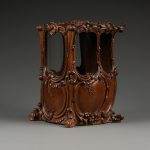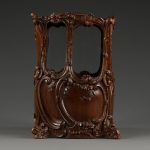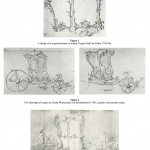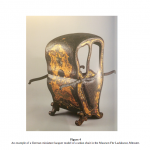11039 AN EXQUISITE CARVED WALNUT ROCOCO CARRIAGE-MAKER’S MODEL FOR A CARROSSE MODERNE, RELATED TO A DRAWING BY GEORG WENCESLAUS VON KNOBELSDORFF Probably German. Eighteenth or Nineteenth Century. Measurements: Height 11½” (30 cm) Width 7¼” (18.4 cm) Depth 7¾” (19.6 cm)

Research
Of walnut. The domed foliate restored carved top rests upon a bombe form body with single forward door. Semi glazed on three sides with exquisitely carved foliate cartouche-shaped panels below. The whole resting on four foliate carved sled feet. Glass replaced. Bottom underneath panel possibly replaced.
Provenance:
UK Collection
The shape of the present carriage model takes the form of the “carrosse moderne” or “grand carrosse,” pioneered under Louis XIV, which, unlike previous half-open designs, featured completely enclosed compartments with windows and filled-in panels. The function of such vehicles was mostly for the purpose of ceremonial arrivals “entrées solennelles” (solemn entries) and parades.1
From the Renaissance onwards carriages, sleighs and sedans had played a vital part in court ceremony throughout Europe, for royal travel, as well as during parades, and many accounts exist describing the sumptuous trains of hundreds of vehicles, prized horses and elaborately dressed coachmen.
The trade in precious coaches had initially been dominated by Italy, to be superseded by France. However, since the middle of the seventeenth century it is known that Berlin had also established a trade in the manufacture of luxury carriages to rival the French production, so much so that the “Berline” became the term for this favored vehicle for royal occasions throughout Europe.
The form of the Berline retains the outward appearance of a traditional coach. However, its essential difference lies in the fact that the front and rear axles are joined together by two stretchers and not a single backbone, like a typical coach model. The result is greater security; in the event of the breaking of a wheel or a line, the carriage does not tip over. The Berline is also lighter and more comfortable, thanks to its suspension, originally made of leather and, later, of metal springs.
Production of coaches at the highest level of taste and quality was particularly encouraged during the reign of Prussia’s first king, Frederick I (r. 1688-1713) and again under Frederick II, who, for his personal use, developed a new level of luxury in coaches, employing the leading carvers and designers to apply his particular interpretation of the rococo to their models.
Contemporary drawings exist demonstrating these stylistic ideals. A design of a coupe (circa 1746-47), of which only the glazed upper section is drawn, is attributed to Johann August Nahl the Elder (figure 1). Two drawings of alternative coupes by Georg Wenceslaus von Knobelsdorff, dating from 1746 can be seen in figure 2. A further drawing of a coach (circa 1746), entitled Staatswagen im Rokokostil reich geschnitzt und verziert…2 is attributed to Hoppenhaupt the Elder (figure 3). The Knobelsdorff and Hoppenhaupt drawings are particularly closely related to the present model.
There is documentary evidence confirming that on 23 May 1746 the king commissioned the design for “eine offene Chaise” from Knobelsdorff for the King of Denmark. This design was approved in a second document of 22 June 1746, ordering its execution. That Knobelsdorff, along with the talented artists Nahl and Hoppenhaupt the Elder, simultaneously received such commissions indicates the high value the king attributed to this field. Already in the preceding year Frederick II had ordered a Staatskarosse (State Coach) as a diplomatic gift for the Russian empress Elizabeth after he learned that she had ordered carriages in Berlin. The work was completed a year later for the staggering sum of 11,282 Thlr 10 Gr and remains to this day in the Armory of the Kremlin Moscow.
Real working construction models were the last phase of the planning and design process for the order of a coach and exclusively reserved for the highest level and most expensive commissions. They extremely rare and exist only from the last quarter of the seventeenth century onward. According to Dr. Monika Kopplin, “We do not know whether they were costly models for full-scale sedans to be commissioned to be covered with painted gold leather or simply show pieces exhibited in the shops of carrossiers or peintres-vernisseurs to show off their skills.”1 An example of a German miniature lacquer model of a sedan chair is published in “European Lacquer: Selected Works from the Museum Fu ür Lackkunst” (Kopplin, 2010) (figure 4).
It is interesting to note that the present carriage is designed to disassemble easily as it is largely held together with screws rather than jointed. This perhaps indicates it was collapsible for ease of transport, as it may well have formed part of a range carried by a representative of the manufacturer and taken to foreign courts and other wealthy clients.
Footnotes:
- Himmelheber, Georg. Kleine Mo öbel: Modell-, Andachts Und Kassettenmo öbel Vom 13. – 20. Jahrhundert ; [ausstellung Im Bayerischen Nationalmuseum, Mu ünchen, 15. Ma ärz – 16. Juni 1979]. Mu ünchen: Dt. Kunstverl, 1979. 45.
- Inventory Number GK 141901, Hohenzollernmuseum, Schloss Monbijou, Berlin.







Comments are closed.